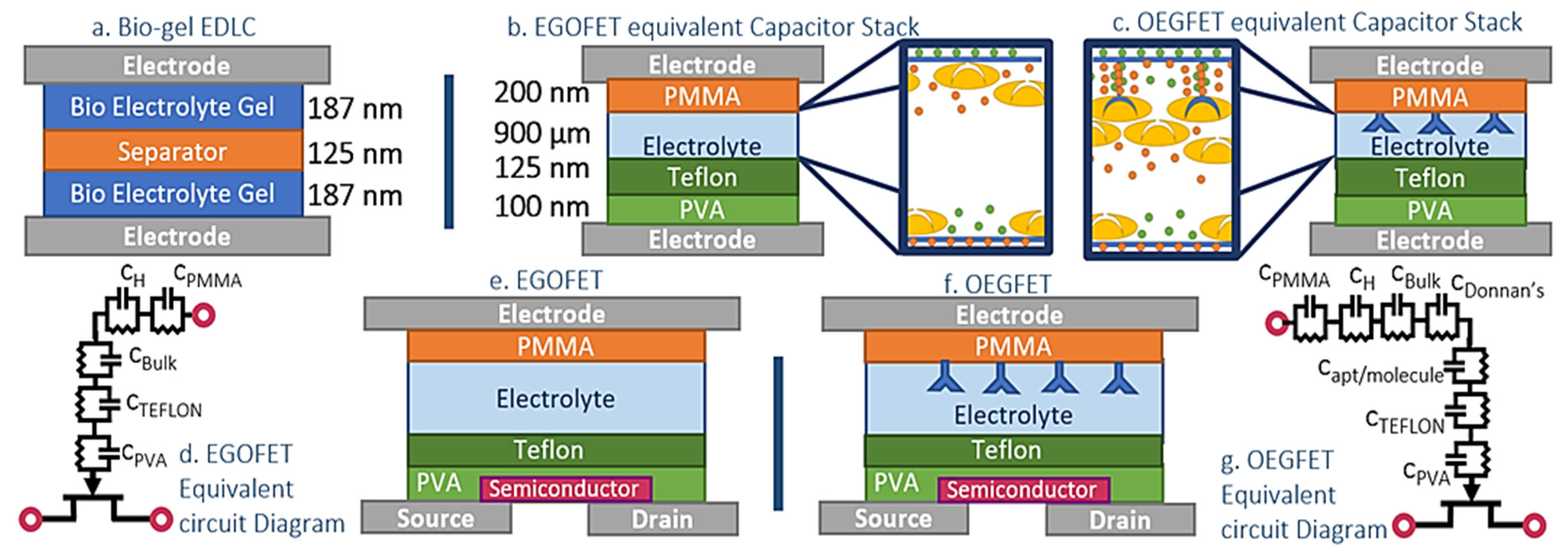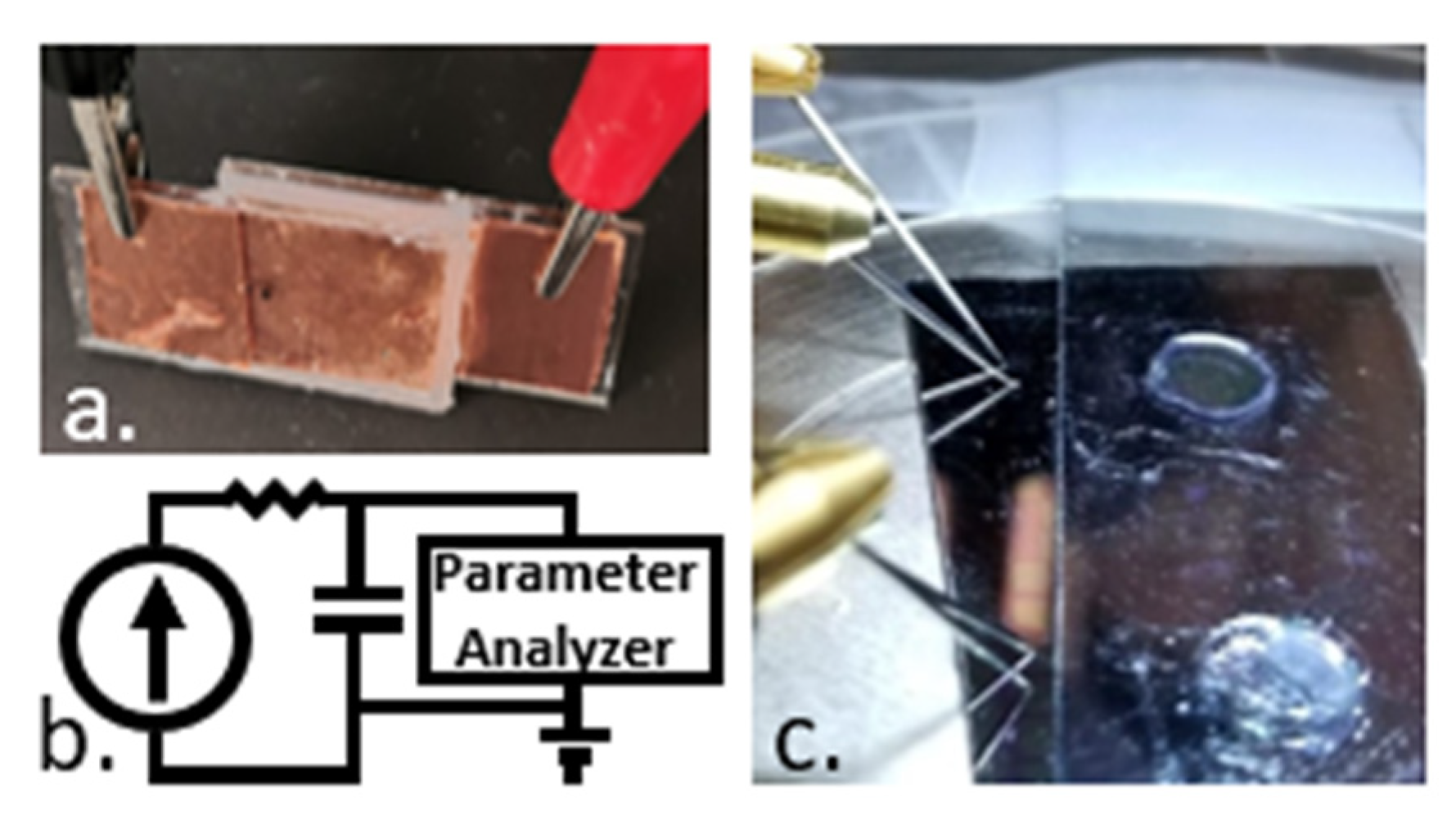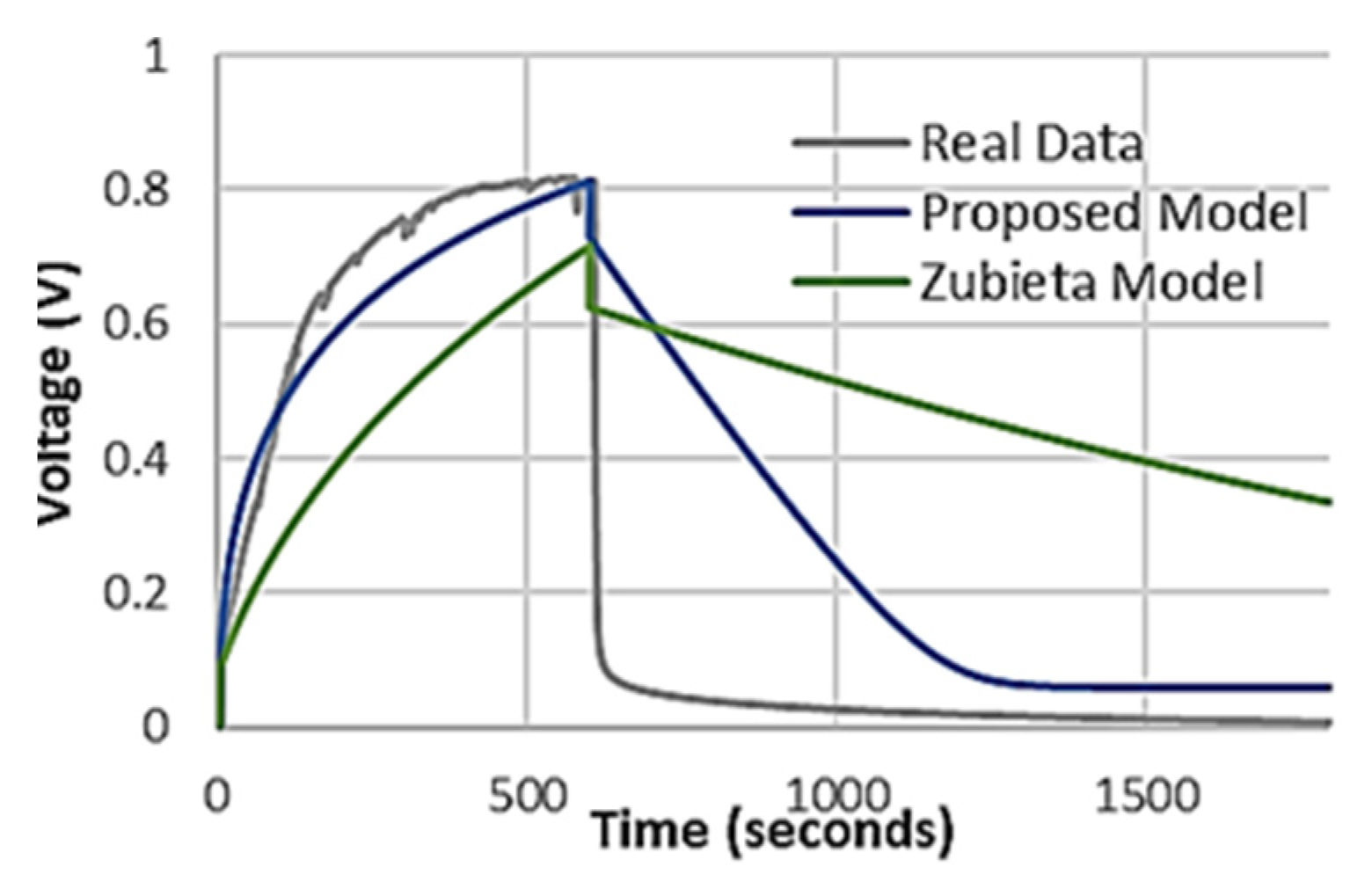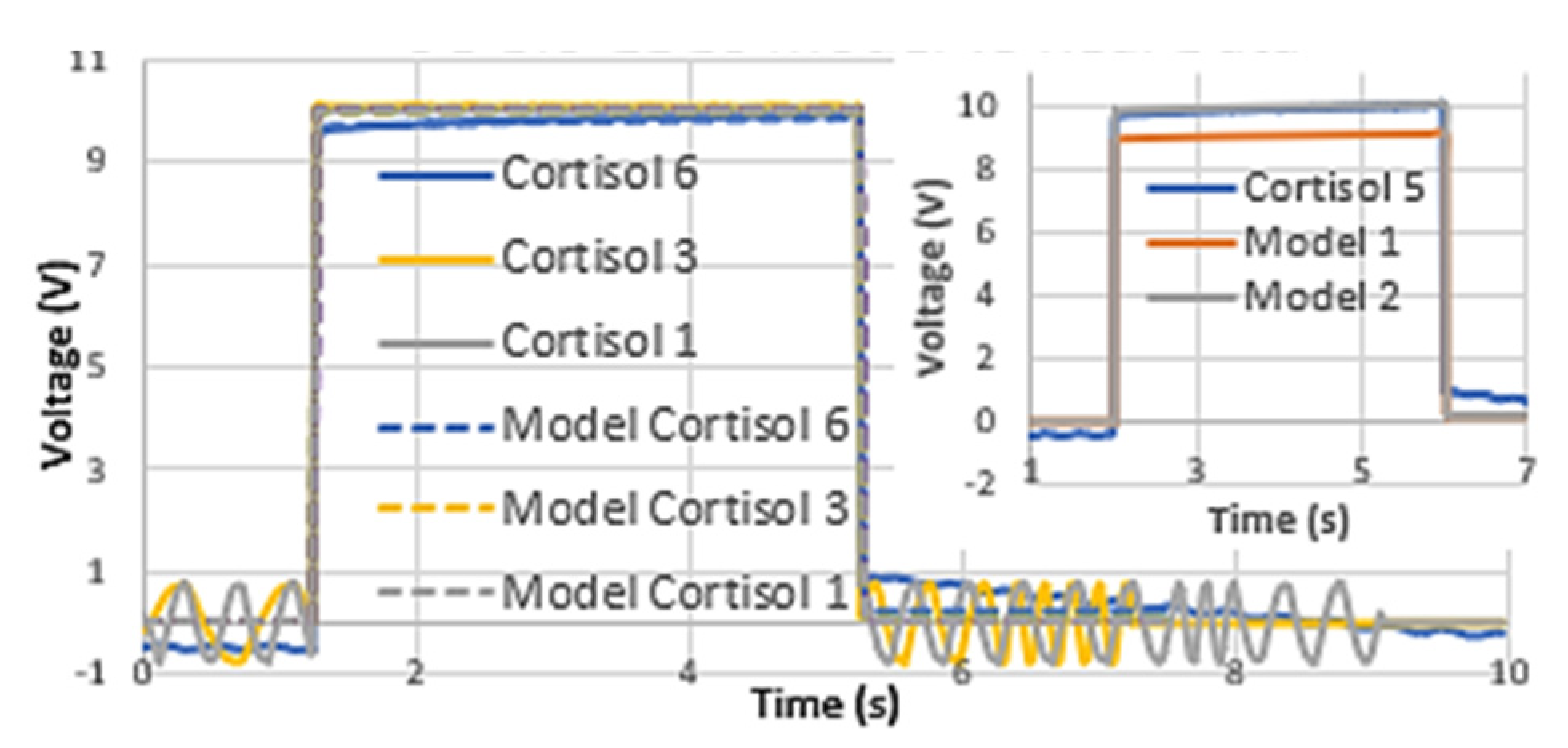Modeling the Double Layer Capacitance Effect in Electrolyte Gated FETs with Gel and Aqueous Electrolytes
Abstract
:1. Introduction
2. Materials and Methods
2.1. Device Fabrication
2.1.1. Standard Bio-Electrolyte DLC Fabrication
2.1.2. EGOFET Equivalent and OEGFET Equivalent Capacitor Stack Fabrication
2.2. Device Testing
2.3. Device Modelling Methods
3. Results
3.1. Bio-Gel EDLC Simulation
3.2. EGOFET Equivalent Capacitor Simulation
3.3. OEGFET Equivalent Capacitor Mechanism Simulation
4. Discussion
4.1. Performance of Bio-Gel EDLCsimulation with Proposed Equivalent Circuit Model
4.2. Performance of EGOFET Equivalent Capacitor Simulation with Proposed Circuit Model 1
4.3. Performance of OEGFET Equivalent Capacitor Simulation with Proposed Circuit Models
5. Conclusions
Author Contributions
Funding
Acknowledgments
Conflicts of Interest
References
- Li, F.; Nathan, A.; Wu, Y.; Ong, B.S. Organic Thin Film Transistor Integration: A Hybrid Approach; John Wiley & Sons: Hoboken, NJ, USA, 2011. [Google Scholar]
- Reyes-Reyes, M.; Carroll, D.L.; Blau, W.; López-Sandoval, R. Materials and Devices for Organic Electronics. J. Nanotechnol. 2011, 2011, 1–2. [Google Scholar] [CrossRef] [Green Version]
- Metkar, S.K.; Girigoswami, K. Diagnostic biosensors in medicine—A review. Biocatal. Agric. Biotechnol. 2019, 17, 271–283. [Google Scholar] [CrossRef]
- Syu, Y.-C.; Hsu, W.-E.; Lin, C.-T. Review—Field-Effect Transistor Biosensing: Devices and Clinical Applications. ECS J. Solid State Sci. Technol. 2018, 7, Q3196–Q3207. [Google Scholar] [CrossRef]
- Massey, R.; Amache, R.; Bebe, S.; Prakash, R. A Comprehensive Modelling Approach for Bio-EDLC Systems; IEEE: Manhattan, NY, USA, 2020; pp. 1–4. [Google Scholar]
- Lu, G.; Liu, Y.; Lin, F.; Gen, K.; Wu, W.J.; Yao, R. Realization of artificial synapse and inverter based on oxide electric-double-layer transistor gated by a chitosan biopolymer electrolyte. Semicond. Sci. Technol. 2020, 35, 075014. [Google Scholar] [CrossRef]
- Zhang, Q.; Leonardi, F.; Pfattner, R.; Mas-Torrent, M. A Solid-State Aqueous Electrolyte-Gated Field-Effect Transistor as a Low-Voltage Operation Pressure-Sensitive Platform. Adv. Mater. Interfaces 2019, 6, 1–8. [Google Scholar] [CrossRef]
- Babeli, I.; Ruano, G.; Casanovas, J.; Ginebra, M.-P.; García-Torres, J.; Alemán, C. Conductive, self-healable and reusable poly(3,4-ethylenedioxythiophene)-based hydrogels for highly sensitive pressure arrays. J. Mater. Chem. C 2020, 8, 8654–8667. [Google Scholar] [CrossRef]
- Sailapu, S.K.; Macchia, E.; Merino-Jimenez, I.; Esquivel, J.P.; Sarcina, L.; Scamarcio, G.; Minteer, S.D.; Torsi, L.; Sabaté, N. Standalone operation of an EGOFET for ultra-sensitive detection of HIV. Biosens. Bioelectron. 2020, 156, 112103. [Google Scholar] [CrossRef]
- Parkula, V.; Maglione, M.S.; Casalini, S.; Zhang, Q.; Greco, P.; Bortolotti, C.A.; Rovira, C.; Mas-Torrent, M.; Biscarini, F. EGOFET Gated by a Molecular Electronic Switch: A Single-Device Memory Cell. Adv. Electron. Mater. 2019, 5, 1800875. [Google Scholar] [CrossRef] [Green Version]
- Nakata, S.; Arie, T.; Akita, S.; Takei, K. Wearable, Flexible, and Multifunctional Healthcare Device with an ISFET Chemical Sensor for Simultaneous Sweat pH and Skin Temperature Monitoring. ACS Sens. 2017, 2, 443–448. [Google Scholar] [CrossRef]
- Blasi, D.; Fabrizio, V.; Modena, F.; Luukkonen, A.; Macchia, E.; Picca, R.A.; Gounani, Z. Printed, cost-effective and stable poly (3-hexylthiophene) electrolyte-gated field-effect transistors. J. Mater. Chem. C 2020, 8, 15312–15321. [Google Scholar] [CrossRef]
- Leonardi, F.; Tamayo, A.; Casalini, S.; Mas-Torrent, M. Modification of the gate electrode by self-assembled monolayers in flexible electrolyte-gated organic field effect transistors: Work function vs. capacitance effects. RSC Adv. 2018, 8, 27509–27515. [Google Scholar] [CrossRef] [Green Version]
- Wadhera, T.; Kakkar, D.; Wadhwa, G.; Raj, B. Recent Advances and Progress in Development of the Field Effect Transistor Biosensor: A Review. J. Electron. Mater. 2019, 48, 7635–7646. [Google Scholar] [CrossRef] [Green Version]
- Massey, R.; Bebe, S.; Prakash, R. Aptamer-Enhanced Organic Electrolyte-Gated FET Biosensor for High-Specificity Detection of Cortisol. IEEE Sensors Lett. 2020, 4, 1–4. [Google Scholar] [CrossRef]
- Wang, G.Y.; Lian, K.; Chu, T.-Y. Electrolyte-Gated Field Effect Transistors in Biological Sensing: A Survey of Electrolytes. IEEE J. Electron Devices Soc. 2021, 9, 939–950. [Google Scholar] [CrossRef]
- Singaraju, S.A.; Baby, T.T.; Neuper, F.; Kruk, R.; Aghassi-Hagmann, J.; Hahn, H.; Breitung, B. Development of Fully Printed Electrolyte-Gated Oxide Transistors Using Graphene Passive Structures. ACS Appl. Electron. Mater. 2019, 1, 1538–1544. [Google Scholar] [CrossRef]
- Von Seggern, F.; Keskin, I.; Koos, E.; Kruk, R.; Hahn, H.; Dasgupta, S. Temperature-Dependent Performance of Printed Field-Effect Transistors with Solid Polymer Electrolyte Gating. ACS Appl. Mater. Interfaces 2016, 8, 31757–31763. [Google Scholar] [CrossRef]
- Martin, R.; Quintana, J.J.; Ramos, A.; de la Nuez, I. Modeling electrochemical double layer capacitor, from classical to fractional impedance. In Proceedings of the MELECON 2008—The 14th IEEE Mediterranean Electrotechnical Conference, Ajaccio, France, 5–7 May 2008; pp. 61–66. [Google Scholar]
- Kim, B.; Sy, S.; Yu, A.; Zhang, J. Electrochemical Supercapacitors for Energy Storage and Conversion Handbook of Clean Energy System; Taylor & Francis: Abingdon, UK, 2015; pp. 1–25. [Google Scholar]
- Marinov, O.; Deen, M.J.; Zschieschang, U.; Klauk, H. Organic Thin-Film Transistors: Part I—Compact DC Modeling. IEEE Trans. Electron Devices 2009, 56, 2952–2961. [Google Scholar] [CrossRef]
- Tibaldi, A.; Fillaud, L.; Anquetin, G.; Woytasik, M.; Zrig, S.; Piro, B.; Mattana, G.; Noël, V. Electrolyte-gated organic field-effect transistors (EGOFETs) as complementary tools to electrochemistry for the study of surface processes. Electrochem. Commun. 2019, 98, 43–46. [Google Scholar] [CrossRef]
- Thomas, M.S.; Adrahtas, D.Z.; Frisbie, C.D.; Dorfman, K.D. Modeling of Quasi-Static Floating-Gate Transistor Biosensors. ACS Sensors 2021, 6, 1910–1917. [Google Scholar] [CrossRef] [PubMed]
- Janata, J. Graphene Bio-Field-Effect Transistor Myth. ECS Solid State Lett. 2012, 1, M29–M31. [Google Scholar] [CrossRef]
- Jiya, I.N.; Gurusinghe, N.; Gouws, R. Electrical Circuit Modelling of Double Layer Capacitors for Power Electronics and Energy Storage Applications: A Review. Electronics 2018, 7, 268. [Google Scholar] [CrossRef] [Green Version]
- Tu, D.; Herlogsson, L.; Kergoat, L.; Crispin, X.; Berggren, M.; Forchheimer, R. A Static Model for Electrolyte-Gated Organic Field-Effect Transistors. IEEE Trans. Electron. Devices 2011, 58, 3574–3582. [Google Scholar] [CrossRef]
- Prakash, R.; Bebe, S.; Amache, R. Planar Bioelectrolytic Capacitors. U.S. Patent Application No. US 62/976,548, 14 February 2020. [Google Scholar]
- Riekkinen, T.; Mattila, T.; Van Dijken, S.; Luker, A.; Zhang, Q.; Kirby, P.B.; Sánchez, A.M. Ferroelectric parallel-plate capacitors with copper electrodes for high-frequency applications. Appl. Phys. Lett. 2007, 91, 252902. [Google Scholar] [CrossRef] [Green Version]
- Seshadri, P.; Manoli, K.; Schneiderhan-Marra, N.; Anthes, U.; Wierzchowiec, P.; Bonrad, K.; Di Franco, C.; Torsi, L. Low-picomolar, label-free procalcitonin analytical detection with an electrolyte-gated organic field-effect transistor based electronic immunosensor. Biosens. Bioelectron. 2018, 104, 113–119. [Google Scholar] [CrossRef] [PubMed]
- Faranda, R.; Gallina, M.; Son, D.T. A new simplified model of double layer capacitors. In Proceedings of the 2007 International Conference on Clean Electrical Power, Capri, Italy, 21–23 May 2007; pp. 706–710. [Google Scholar]
- Pucci, M.; Vitale, G.; Cirrincione, M.; Cirrincione, G. Parameter identification of a Double-Layer-Capacitor 2-branch model by a least-squares method. In Proceedings of the IECON 2013—39th Annual Conference of the IEEE Industrial Electronics Society, Vienna, Austria, 10–13 November 2013; pp. 6770–6776. [Google Scholar]
- Brus, V.V.; Kyaw, A.K.K.; Maryanchuk, P.; Zhang, J. Quantifying interface states and bulk defects in high-efficiency solution-processed small-molecule solar cells by impedance and capacitance characteristics. Prog. Photovolt. Res. Appl. 2015, 23, 1526–1535. [Google Scholar] [CrossRef]
- Yan, Z.; Zhu, L.; Li, Y.C.; Wycisk, R.J.; Pintauro, P.N.; Hickner, M.A.; Mallouk, T.E. The balance of electric field and interfacial catalysis in promoting water dissociation in bipolar membranes. Energy Environ. Sci. 2018, 11, 2235–2245. [Google Scholar] [CrossRef]
- Nichicon, Aluminum Electrolytic Capacitors, TVX 02 Type, CAT.8100I. Available online: https://www.nichicon.co.jp/english/products/pdf/aluminum.pdf (accessed on 1 December 2021).
- KEMET Electronics Corporation, A4084_ALF70, Press-Fit Aluminum Electrolytic Capacitors. 2020. Available online: https://content.kemet.com/datasheets/KEM_A4084_ALF70.pdf (accessed on 1 December 2021).
- Murata Manufacturing Co., Ltd. O8E3 High Performance Supercapacitor (EDLC) DMF Series, Cat. No. O83E-3. July 2016. Available online: https://www.avnet.com/wps/wcm/connect/onesite/111144f9-6cbc-43b2-9d9d-0c1e392c7cd5/Murata-DMF-EN-datasheet.pdf?MOD=AJPERES&CVID=lZO.YxC&CVID=lZO.YxC&CVID=lZO.YxC&CVID=lZO.YxC (accessed on 1 December 2021).
- Zubieta, L.; Bonert, R. Characterization of double-layer capacitors (DLCs) for power electronics applications. In Proceedings of the Conference Record of 1998 IEEE Industry Applications Conference, St. Louis, MO, USA, 12–15 October 1998; pp. 12–15. [Google Scholar]
- Negroiu, R.; Svasta, P.; Vasile, A.; Ionescu, C.; Marghescu, C. Comparison between Zubieta DLC model of supercapacitors and their real behavior. In Proceedings of the 2016 IEEE 22nd International Symposium for Design and Technology in Elect, Oradea, Romania, 20–23 October 2016. [Google Scholar]
- Zubieta, L.; Bonert, R. Characterization of double-layer capacitors for power electronics applications. IEEE Trans. Ind. Appl. 2000, 36, 199–205. [Google Scholar] [CrossRef] [Green Version]
- Hou, Y.; Aoki, K.J.; Chen, J.; Nishiumi, T. Invariance of double layer capacitance to polarized potential in halide solutions. Univ. J. Chem. 2013, 1, 162–169. [Google Scholar] [CrossRef]
- Hou, Y.; Aoki, K.J.; Chen, J.; Nishiumi, T. Solvent Variables Controlling Electric Double Layer Capacitance at the Metal–Solution Interface. J. Phys. Chem. C 2014, 118, 10153–10158. [Google Scholar] [CrossRef]
- Pozo, B.; Garate, J.I.; Ferreiro, S.; Fernandez, I.; De Gorostiza, E.F. Supercapacitor Electro-Mathematical and Machine Learning Modelling for Low Power Applications. Electronics 2018, 7, 44. [Google Scholar] [CrossRef] [Green Version]
- Canales, M.; Guàrdia, E. Water-water and ion-water hydrogen bonding in sulfuric acid solutions. J. Mol. Liq. 2019, 293, 111463. [Google Scholar] [CrossRef]







Publisher’s Note: MDPI stays neutral with regard to jurisdictional claims in published maps and institutional affiliations. |
© 2021 by the authors. Licensee MDPI, Basel, Switzerland. This article is an open access article distributed under the terms and conditions of the Creative Commons Attribution (CC BY) license (https://creativecommons.org/licenses/by/4.0/).
Share and Cite
Massey, R.S.; Prakash, R. Modeling the Double Layer Capacitance Effect in Electrolyte Gated FETs with Gel and Aqueous Electrolytes. Micromachines 2021, 12, 1569. https://doi.org/10.3390/mi12121569
Massey RS, Prakash R. Modeling the Double Layer Capacitance Effect in Electrolyte Gated FETs with Gel and Aqueous Electrolytes. Micromachines. 2021; 12(12):1569. https://doi.org/10.3390/mi12121569
Chicago/Turabian StyleMassey, Roslyn S., and Ravi Prakash. 2021. "Modeling the Double Layer Capacitance Effect in Electrolyte Gated FETs with Gel and Aqueous Electrolytes" Micromachines 12, no. 12: 1569. https://doi.org/10.3390/mi12121569
APA StyleMassey, R. S., & Prakash, R. (2021). Modeling the Double Layer Capacitance Effect in Electrolyte Gated FETs with Gel and Aqueous Electrolytes. Micromachines, 12(12), 1569. https://doi.org/10.3390/mi12121569





